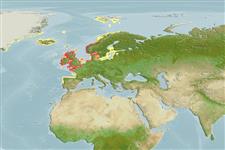Classification / Names
Common names from other countries
Main reference
Size / Weight / Age
Max length : 18.0 cm TL male/unsexed; (Ref. 4645); common length : 12.0 cm TL male/unsexed; (Ref. 3397); max. reported age: 6 years (Ref. 4792)
Environment
Marine; reef-associated
Climate / Range
Temperate, preferred ?
Distribution
Short description
Dorsal
spines
(total): 18 - 20;
Dorsal
soft rays
(total): 5-7;
Anal
spines: 4-6;
Anal
soft rays: 6 - 8. Snout with 5-10 pores. Upper lip with 5-7 folds. Rows of scales on cheek 3-5, on inter-operculum 2 (7-11) scales, on temporo-occipital surface 5-8. Vertebrae 32-34. Preoperculum edge serrated. One row of scales on base of soft part of dorsal and anal fins (Ref. 232). No black spots on the body or fins (Ref. 35388).
IUCN Red List Status (Ref. 115185)
Threat to humans
Harmless
Human uses
Fisheries: of no interest; aquarium: public aquariums
More information
ReferencesAquacultureAquaculture profileStrainsGeneticsAllele frequenciesHeritabilityDiseasesProcessingMass conversion
Tools
Special reports
Download XML
Internet sources
Estimates of some properties based on models
Phylogenetic diversity index
PD50 = 0.7500 many relatives (e.g. carps) 0.5 - 2.0 few relatives (e.g. lungfishes)
Trophic Level
3.5 ±0.50 se; Based on food items.
Resilience
Medium, minimum population doubling time 1.4 - 4.4 years (K=0.69-0.81; tmax=6)
Vulnerability
Low vulnerability (20 of 100)
Price category
